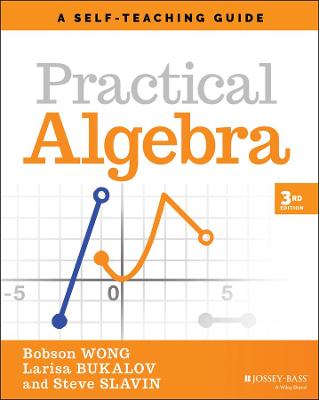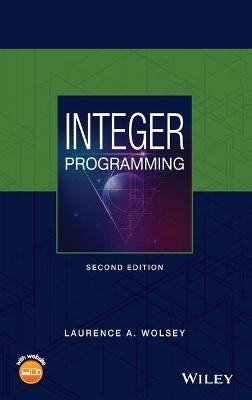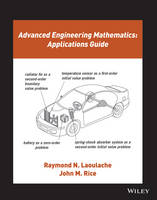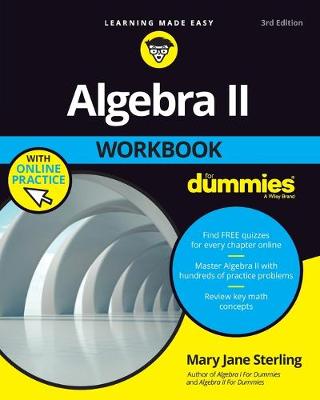Explorations in College Algebra
Explorations in College Algebra
; ;
John Wiley & Sons Inc
10/2017
720
Loose-leaf
Inglês
9781119392972
1165
Descrição não disponível.
1 An Introduction to Data and Functions 1 1.1 Describing Single-Variable Data 1 Visualizing Single-Variable Data 2 Numerical Descriptors: What Is "Average" Anyway? 4 An Introduction to Explore & Extend 5 An Introduction to Algebra Aerobics 5 1.2 Describing Relationships Between Two Variables 9 Visualizing Two-Variable Data 9 Constructing a "60-Second Summary" 10 Using Equations to Describe Change 12 1.3 An Introduction to Functions 18 What Is a Function? 18 Representing Functions: Words, Tables, Graphs, and Equations 18 Input and Output: Independent and Dependent Variables 19 When Is a Relationship Not a Function? 20 1.4 The Language of Functions 24 Function Notation 24 Finding Output Values: Evaluating a Function 25 Finding Input Values: Solving Equations 25 Finding Input and Output Values from Tables and Graphs 26 Rewriting Equations Using Function Notation 26 Domain and Range 29 1.5 Visualizing Functions 34 Is There a Maximum or Minimum Value? 34 When Is the Output of the Function Positive, Negative, or Zero? 35 Is the Function Increasing or Decreasing? 35 Is the Graph Concave Up or Concave Down? 36 Getting the Big Idea 37 Chapter Summary 45 Check Your Understanding 46 Chapter 1 Review: Putting It All Together 48 2 Rates of Change and Linear Functions 53 2.1 Average Rates of Change 53 Describing Change in the U.S. Population over Time 53 Defining the Average Rate of Change 55 Limitations of the Average Rate of Change 56 2.2 Change in the Average Rate of Change 59 2.3 The Average Rate of Change Is a Slope 64 Calculating Slopes 64 2.4 Putting a Slant on Data 69 Slanting the Slope: Choosing Different End Points 69 Slanting the Data with Words and Graphs 70 2.5 Linear Functions: When Rates of Change Are Constant 75 What If the U.S. Population Had Grown at a Constant Rate? A Hypothetical Example 75 The General Equation for a Linear Function 78 2.6 Visualizing Linear Functions 81 The Effect of m 82 2.7 Constructing Graphs and Equations of Linear Functions 87 Finding the Graph 87 Finding the Equation 89 2.8 Special Cases 94 Direct Proportionality 94 Horizontal and Vertical Lines 97 Parallel and Perpendicular Lines 99 2.9 Breaking the Line: Piecewise Linear Functions 104 Piecewise Linear Functions 104 2.10 Constructing Linear Models of Data 111 Fitting a Line to Data: The Kalama Study 111 Reinitializing the Independent Variable 113 Interpolation and Extrapolation: Making Predictions 114 2.11 Looking for Links Between Education and Earnings: A Case Study on Using Regression Lines 120 Using U.S. Census Data 120 Summarizing the Data: Regression Lines 121 Interpreting Regression Lines: Correlation vs. Causation 124 Raising More Questions: Going Deeper 125 Chapter Summary 132 Check Your Understanding 132 Chapter 2 Review: Putting It All Together 135 3 When Lines Meet: Linear Systems 141 3.1 Interpreting Intersection Points: Linear and Nonlinear Systems 141 When Curves Collide: Nonlinear Systems 141 When Lines Meet: Linear Systems 144 3.2 Visualizing and Solving Linear Systems 151 Visualizing Linear Systems 151 Strategies for Solving Linear Systems 152 Systems with No Solution or Infinitely Many Solutions 154 Linear Systems in Economics: Supply and Demand 156 3.3 Reading Between the Lines: Linear Inequalities 161 Above and Below the Line 161 Reading Between the Lines 162 Manipulating Inequalities 164 Breakeven Points: Regions of Profit or Loss 165 3.4 Systems with Piecewise Linear Functions: Tax Plans 171 Graduated vs. Flat Income Tax 171 Comparing the Flat and Graduated Tax Plans 174 Chapter Summary 177 Check Your Understanding 178 Chapter 3 Review: Putting It All Together 180 4 The Laws of Exponents and Logarithms: Measuring the Universe 185 4.1 The Numbers of Science: Measuring Time and Space 185 Powers of 10 and the Metric System 185 Scientific Notation 188 4.2 Positive Integer Exponents 192 Exponent Rules 193 Common Errors 195 Estimating Answers 196 4.3 Zero, Negative, and Fractional Exponents 200 Zero and Negative Exponents 200 Evaluating (a/b)-n 201 Fractional Exponents 202 Expressions of the Form a1/2: Square Roots 202 nth Roots: Expressions of the Form a1/n 203 Rules for Radicals 204 Expressions of the Form am/n 206 4.4 Converting Units 210 Converting Units Within the Metric System 210 Converting Between the Metric and English Systems 211 Using Multiple Conversion Factors 211 4.5 Orders of Magnitude 214 Comparing Numbers of Widely Differing Sizes 214 Orders of Magnitude 214 Graphing Numbers of Widely Differing Sizes: Log Scales 215 4.6 Logarithms as Numbers 218 Finding the Logarithms of Powers of 10 219 When is log10x Not Defined? 220 Finding the Logarithm of Any Positive Number 221 Plotting Numbers on a Logarithmic Scale 222 Chapter Summary 226 Check Your Understanding 226 Chapter 4 Review: Putting It All Together 227 5 Growth and Decay: An Introduction to Exponential Functions 231 5.1 Exponential Growth 231 The Growth of E. coli Bacteria 231 The General Exponential Growth Function 233 Doubling Time 234 Looking at Real Growth Data for E. coli Bacteria 236 5.2 Exponential Decay 239 The Decay of Iodine-131 239 The General Exponential Decay Function 240 Half-Life 241 5.3 Comparing Linear and Exponential Functions 245 Linear Functions 246 Exponential Functions 246 Identifying Exponential Functions in a Data Table 246 A Linear vs. an Exponential Model Through Two Points 247 Comparing the Average Rates of Change 249 In the Long Run, Exponential Growth Will Always Outpace Linear Growth 250 5.4 Visualizing Exponential Functions 253 The Graphs of Exponential Functions 253 The Effect of the Base a 253 The Effect of the Initial Value C 254 Horizontal Asymptotes 256 5.5 Exponential Functions: A Constant Percent Change 259 Exponential Growth: Increasing by a Constant Percent 259 Exponential Decay: Decreasing by a Constant Percent 260 Revisiting Linear vs. Exponential Functions 262 5.6 More Examples of Exponential Growth and Decay 267 Returning to Doubling Times and Half-Lives 268 The Malthusian Dilemma 275 Forming a Fractal Tree 276 5.7 Compound Interest and the Number e 283 Compounding at Different Intervals 284 Continuous Compounding Using e 286 Continuous Compounding Formula 286 Exponential Functions Base e 287 Converting ek into a 289 5.8 Semi-Log Plots of Exponential Functions 293 Chapter Summary 297 Check Your Understanding 298 Chapter 5 Review: Putting It All Together 300 6 Logarithmic Links: Logarithmic and Exponential Functions 305 6.1 Using Logarithms to Solve Exponential Equations 305 Estimating Solutions to Exponential Equations 305 Rules for Logarithms 307 Solving Exponential Equations Using Logarithms 310 Solving for Doubling Times and Half-Lives 311 6.2 Using Natural Logarithms to Solve Exponential Equations Base e 315 The Natural Logarithm 315 Returning to Doubling Times and Half-Lives 317 Converting Exponential Functions from Base a to Base e 319 6.3 Visualizing and Applying Logarithmic Functions 324 The Graphs of Logarithmic Functions 324 Logarithmic Growth 324 Inverse Functions: Logarithmic vs. Exponential 326 Applications of Logarithmic Functions 329 6.4 Using Semi-Log Plots to Construct Exponential Models for Data 334 Why Do Semi-Log Plots of Exponential Functions Produce Straight Lines? 335 Chapter Summary 339 Check Your Understanding 340 Chapter 6 Review: Putting It All Together 341 7 Power Functions 345 7.1 The Tension between Surface Area and Volume 345 Scaling Up a Cube 345 Size and Shape 348 7.2 Direct Proportionality: Power Functions with Positive Powers 350 Direct Proportionality 351 Properties of Direct Proportionality 352 Direct Proportionality with More Than One Variable 355 7.3 Visualizing Positive Integer Power Functions 358 The Graphs of f(x) =x2 and g(x) =x3 358 Odd vs. Even Positive Integer Powers 359 The Effect of the Coefficient k 361 7.4 Comparing Power and Exponential Functions 365 Which Eventually Grows Faster, a Power Function or an Exponential Function? 365 7.5 Inverse Proportionality: Power Functions with Negative Powers 369 Inverse Proportionality 370 Properties of Inverse Proportionality 372 Inverse Square Laws 375 7.6 Visualizing Negative Integer Power Functions 380 The Graphs of f(x) =x 1 and g(x) =x 2 380 Odd vs. Even Negative Integer Powers 382 The Effect of the Coefficient k 383 7.7 Using Logarithmic Scales to Find the Best Functional Model 389 Looking for Lines 389 Why Is a Log-Log Plot of a Power Function a Straight Line? 390 Translating Power Functions into Equivalent Logarithmic Functions 390 Analyzing Weight and Height Data 391 Allometry: The Effect of Scale 394 Chapter Summary 402 Check Your Understanding 403 Chapter 7 Review: Putting It All Together 404 8 Quadratics and the Mathematics of Motion 409 8.1 An Introduction to Quadratic Functions: The Standard Form 409 The Simplest Quadratic 409 Designing Parabolic Devices 410 The Standard Form of a Quadratic 411 Properties of Quadratic Functions 412 8.2 Visualizing Quadratics: The Vertex Form 418 Stretching and Compressing Vertically 418 Reflecting Across the Horizontal Axis 418 Shifting Vertically and Horizontally 420 Using Transformations to Get the Vertex Form 423 8.3 The Standard Form vs. the Vertex Form 426 Finding the Vertex from the Standard Form 426 Converting Between Standard and Vertex Forms 428 8.4 Finding the Horizontal Intercepts: The Factored Form 435 Using Factoring to Find the Horizontal Intercepts 435 Factoring Quadratics 436 Using the Quadratic Formula to Find the Horizontal Intercepts 439 The Factored Form 442 Standard, Factored and Vertex Forms 445 8.5 The Average Rate of Change of a Quadratic Function 448 Generalizing to All Quadratic Functions 449 8.6 The Mathematics of Motion 453 The Scientific Method 454 The Free Fall Experiment 454 Deriving an Equation Relating Distance and Time 454 Velocity: Change in Distance over Time 456 Acceleration: Change in Velocity over Time 458 Deriving an Equation for the Height of an Object in Free Fall 460 Working with an Initial Upward Velocity 463 Chapter Summary 468 Check Your Understanding 469 Chapter 8 Review: Putting It All Together 470 9 New Functions from Old 473 9.1 Transformations 473 Transforming a Function 473 9.2 The Algebra of Functions 485 9.3 Polynomials: The Sum of Power Functions 492 Defining a Polynomial Function 493 Visualizing Polynomial Functions 495 Finding the Vertical Intercept 498 Finding the Horizontal Intercepts 499 9.4 Rational Functions: The Quotient of Polynomials 505 Building a Rational Function: Finding the Average Cost of an MRI Machine 505 Defining a Rational Function 506 Visualizing Rational Functions 507 9.5 Composition and Inverse Functions 514 Composing Two Functions 514 Composing More Than Two Functions 516 Inverse Functions: Returning the Original Value 518 9.6 Exploring, Extending & Expanding 528 Chapter Summary 531 Check Your Understanding 532 Chapter 9 Review: Putting It All Together 534 ANSWERS For all Algebra Aerobics and Check Your Understanding problems; for odd numbered problems in the Exercises and Chapter Reviews. All answers are grouped by chapter. ANS-1 Index I-1
Este título pertence ao(s) assunto(s) indicados(s). Para ver outros títulos clique no assunto desejado.
college; explorations; etext; kime; linda; isbn; option; etextbook; print version; textbook; quot; card; math; mylab; plus; package; carte; pearson; access; algebra; graphing utilities; jan
1 An Introduction to Data and Functions 1 1.1 Describing Single-Variable Data 1 Visualizing Single-Variable Data 2 Numerical Descriptors: What Is "Average" Anyway? 4 An Introduction to Explore & Extend 5 An Introduction to Algebra Aerobics 5 1.2 Describing Relationships Between Two Variables 9 Visualizing Two-Variable Data 9 Constructing a "60-Second Summary" 10 Using Equations to Describe Change 12 1.3 An Introduction to Functions 18 What Is a Function? 18 Representing Functions: Words, Tables, Graphs, and Equations 18 Input and Output: Independent and Dependent Variables 19 When Is a Relationship Not a Function? 20 1.4 The Language of Functions 24 Function Notation 24 Finding Output Values: Evaluating a Function 25 Finding Input Values: Solving Equations 25 Finding Input and Output Values from Tables and Graphs 26 Rewriting Equations Using Function Notation 26 Domain and Range 29 1.5 Visualizing Functions 34 Is There a Maximum or Minimum Value? 34 When Is the Output of the Function Positive, Negative, or Zero? 35 Is the Function Increasing or Decreasing? 35 Is the Graph Concave Up or Concave Down? 36 Getting the Big Idea 37 Chapter Summary 45 Check Your Understanding 46 Chapter 1 Review: Putting It All Together 48 2 Rates of Change and Linear Functions 53 2.1 Average Rates of Change 53 Describing Change in the U.S. Population over Time 53 Defining the Average Rate of Change 55 Limitations of the Average Rate of Change 56 2.2 Change in the Average Rate of Change 59 2.3 The Average Rate of Change Is a Slope 64 Calculating Slopes 64 2.4 Putting a Slant on Data 69 Slanting the Slope: Choosing Different End Points 69 Slanting the Data with Words and Graphs 70 2.5 Linear Functions: When Rates of Change Are Constant 75 What If the U.S. Population Had Grown at a Constant Rate? A Hypothetical Example 75 The General Equation for a Linear Function 78 2.6 Visualizing Linear Functions 81 The Effect of m 82 2.7 Constructing Graphs and Equations of Linear Functions 87 Finding the Graph 87 Finding the Equation 89 2.8 Special Cases 94 Direct Proportionality 94 Horizontal and Vertical Lines 97 Parallel and Perpendicular Lines 99 2.9 Breaking the Line: Piecewise Linear Functions 104 Piecewise Linear Functions 104 2.10 Constructing Linear Models of Data 111 Fitting a Line to Data: The Kalama Study 111 Reinitializing the Independent Variable 113 Interpolation and Extrapolation: Making Predictions 114 2.11 Looking for Links Between Education and Earnings: A Case Study on Using Regression Lines 120 Using U.S. Census Data 120 Summarizing the Data: Regression Lines 121 Interpreting Regression Lines: Correlation vs. Causation 124 Raising More Questions: Going Deeper 125 Chapter Summary 132 Check Your Understanding 132 Chapter 2 Review: Putting It All Together 135 3 When Lines Meet: Linear Systems 141 3.1 Interpreting Intersection Points: Linear and Nonlinear Systems 141 When Curves Collide: Nonlinear Systems 141 When Lines Meet: Linear Systems 144 3.2 Visualizing and Solving Linear Systems 151 Visualizing Linear Systems 151 Strategies for Solving Linear Systems 152 Systems with No Solution or Infinitely Many Solutions 154 Linear Systems in Economics: Supply and Demand 156 3.3 Reading Between the Lines: Linear Inequalities 161 Above and Below the Line 161 Reading Between the Lines 162 Manipulating Inequalities 164 Breakeven Points: Regions of Profit or Loss 165 3.4 Systems with Piecewise Linear Functions: Tax Plans 171 Graduated vs. Flat Income Tax 171 Comparing the Flat and Graduated Tax Plans 174 Chapter Summary 177 Check Your Understanding 178 Chapter 3 Review: Putting It All Together 180 4 The Laws of Exponents and Logarithms: Measuring the Universe 185 4.1 The Numbers of Science: Measuring Time and Space 185 Powers of 10 and the Metric System 185 Scientific Notation 188 4.2 Positive Integer Exponents 192 Exponent Rules 193 Common Errors 195 Estimating Answers 196 4.3 Zero, Negative, and Fractional Exponents 200 Zero and Negative Exponents 200 Evaluating (a/b)-n 201 Fractional Exponents 202 Expressions of the Form a1/2: Square Roots 202 nth Roots: Expressions of the Form a1/n 203 Rules for Radicals 204 Expressions of the Form am/n 206 4.4 Converting Units 210 Converting Units Within the Metric System 210 Converting Between the Metric and English Systems 211 Using Multiple Conversion Factors 211 4.5 Orders of Magnitude 214 Comparing Numbers of Widely Differing Sizes 214 Orders of Magnitude 214 Graphing Numbers of Widely Differing Sizes: Log Scales 215 4.6 Logarithms as Numbers 218 Finding the Logarithms of Powers of 10 219 When is log10x Not Defined? 220 Finding the Logarithm of Any Positive Number 221 Plotting Numbers on a Logarithmic Scale 222 Chapter Summary 226 Check Your Understanding 226 Chapter 4 Review: Putting It All Together 227 5 Growth and Decay: An Introduction to Exponential Functions 231 5.1 Exponential Growth 231 The Growth of E. coli Bacteria 231 The General Exponential Growth Function 233 Doubling Time 234 Looking at Real Growth Data for E. coli Bacteria 236 5.2 Exponential Decay 239 The Decay of Iodine-131 239 The General Exponential Decay Function 240 Half-Life 241 5.3 Comparing Linear and Exponential Functions 245 Linear Functions 246 Exponential Functions 246 Identifying Exponential Functions in a Data Table 246 A Linear vs. an Exponential Model Through Two Points 247 Comparing the Average Rates of Change 249 In the Long Run, Exponential Growth Will Always Outpace Linear Growth 250 5.4 Visualizing Exponential Functions 253 The Graphs of Exponential Functions 253 The Effect of the Base a 253 The Effect of the Initial Value C 254 Horizontal Asymptotes 256 5.5 Exponential Functions: A Constant Percent Change 259 Exponential Growth: Increasing by a Constant Percent 259 Exponential Decay: Decreasing by a Constant Percent 260 Revisiting Linear vs. Exponential Functions 262 5.6 More Examples of Exponential Growth and Decay 267 Returning to Doubling Times and Half-Lives 268 The Malthusian Dilemma 275 Forming a Fractal Tree 276 5.7 Compound Interest and the Number e 283 Compounding at Different Intervals 284 Continuous Compounding Using e 286 Continuous Compounding Formula 286 Exponential Functions Base e 287 Converting ek into a 289 5.8 Semi-Log Plots of Exponential Functions 293 Chapter Summary 297 Check Your Understanding 298 Chapter 5 Review: Putting It All Together 300 6 Logarithmic Links: Logarithmic and Exponential Functions 305 6.1 Using Logarithms to Solve Exponential Equations 305 Estimating Solutions to Exponential Equations 305 Rules for Logarithms 307 Solving Exponential Equations Using Logarithms 310 Solving for Doubling Times and Half-Lives 311 6.2 Using Natural Logarithms to Solve Exponential Equations Base e 315 The Natural Logarithm 315 Returning to Doubling Times and Half-Lives 317 Converting Exponential Functions from Base a to Base e 319 6.3 Visualizing and Applying Logarithmic Functions 324 The Graphs of Logarithmic Functions 324 Logarithmic Growth 324 Inverse Functions: Logarithmic vs. Exponential 326 Applications of Logarithmic Functions 329 6.4 Using Semi-Log Plots to Construct Exponential Models for Data 334 Why Do Semi-Log Plots of Exponential Functions Produce Straight Lines? 335 Chapter Summary 339 Check Your Understanding 340 Chapter 6 Review: Putting It All Together 341 7 Power Functions 345 7.1 The Tension between Surface Area and Volume 345 Scaling Up a Cube 345 Size and Shape 348 7.2 Direct Proportionality: Power Functions with Positive Powers 350 Direct Proportionality 351 Properties of Direct Proportionality 352 Direct Proportionality with More Than One Variable 355 7.3 Visualizing Positive Integer Power Functions 358 The Graphs of f(x) =x2 and g(x) =x3 358 Odd vs. Even Positive Integer Powers 359 The Effect of the Coefficient k 361 7.4 Comparing Power and Exponential Functions 365 Which Eventually Grows Faster, a Power Function or an Exponential Function? 365 7.5 Inverse Proportionality: Power Functions with Negative Powers 369 Inverse Proportionality 370 Properties of Inverse Proportionality 372 Inverse Square Laws 375 7.6 Visualizing Negative Integer Power Functions 380 The Graphs of f(x) =x 1 and g(x) =x 2 380 Odd vs. Even Negative Integer Powers 382 The Effect of the Coefficient k 383 7.7 Using Logarithmic Scales to Find the Best Functional Model 389 Looking for Lines 389 Why Is a Log-Log Plot of a Power Function a Straight Line? 390 Translating Power Functions into Equivalent Logarithmic Functions 390 Analyzing Weight and Height Data 391 Allometry: The Effect of Scale 394 Chapter Summary 402 Check Your Understanding 403 Chapter 7 Review: Putting It All Together 404 8 Quadratics and the Mathematics of Motion 409 8.1 An Introduction to Quadratic Functions: The Standard Form 409 The Simplest Quadratic 409 Designing Parabolic Devices 410 The Standard Form of a Quadratic 411 Properties of Quadratic Functions 412 8.2 Visualizing Quadratics: The Vertex Form 418 Stretching and Compressing Vertically 418 Reflecting Across the Horizontal Axis 418 Shifting Vertically and Horizontally 420 Using Transformations to Get the Vertex Form 423 8.3 The Standard Form vs. the Vertex Form 426 Finding the Vertex from the Standard Form 426 Converting Between Standard and Vertex Forms 428 8.4 Finding the Horizontal Intercepts: The Factored Form 435 Using Factoring to Find the Horizontal Intercepts 435 Factoring Quadratics 436 Using the Quadratic Formula to Find the Horizontal Intercepts 439 The Factored Form 442 Standard, Factored and Vertex Forms 445 8.5 The Average Rate of Change of a Quadratic Function 448 Generalizing to All Quadratic Functions 449 8.6 The Mathematics of Motion 453 The Scientific Method 454 The Free Fall Experiment 454 Deriving an Equation Relating Distance and Time 454 Velocity: Change in Distance over Time 456 Acceleration: Change in Velocity over Time 458 Deriving an Equation for the Height of an Object in Free Fall 460 Working with an Initial Upward Velocity 463 Chapter Summary 468 Check Your Understanding 469 Chapter 8 Review: Putting It All Together 470 9 New Functions from Old 473 9.1 Transformations 473 Transforming a Function 473 9.2 The Algebra of Functions 485 9.3 Polynomials: The Sum of Power Functions 492 Defining a Polynomial Function 493 Visualizing Polynomial Functions 495 Finding the Vertical Intercept 498 Finding the Horizontal Intercepts 499 9.4 Rational Functions: The Quotient of Polynomials 505 Building a Rational Function: Finding the Average Cost of an MRI Machine 505 Defining a Rational Function 506 Visualizing Rational Functions 507 9.5 Composition and Inverse Functions 514 Composing Two Functions 514 Composing More Than Two Functions 516 Inverse Functions: Returning the Original Value 518 9.6 Exploring, Extending & Expanding 528 Chapter Summary 531 Check Your Understanding 532 Chapter 9 Review: Putting It All Together 534 ANSWERS For all Algebra Aerobics and Check Your Understanding problems; for odd numbered problems in the Exercises and Chapter Reviews. All answers are grouped by chapter. ANS-1 Index I-1
Este título pertence ao(s) assunto(s) indicados(s). Para ver outros títulos clique no assunto desejado.













